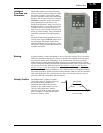
SJ300 Inverter
Getting Started
1–17
Frequently Asked Questions
Q. What is the main advantage in using an inverter to drive a motor, compared to alternative
solutions?
A. An inverter can vary the motor speed with very little energy loss, unlike mechanical
or hydraulic speed control solutions. The resulting energy savings can often pay for
the inverter in a relatively short time.
Q. The term “inverter” is a little confusing, since we also use “drive” and “amplifier” to
describe the electronic unit that controls a motor. What does “inverter” mean?
A. The terms are used somewhat interchangeably in industry. Nowadays, the terms
drive, variable-frequency drive, variable-speed drive, and inverter are generally used
to describe electronic, microprocessor-based motor speed controllers. In the past,
variable speed drive also referred to various mechanical means to vary speed. Ampli-
fier is a term almost exclusively used to describe drives for servo or stepper motors.
Q. Although the SJ300 inverter is a variable speed drive, can I use it in a fixed-speed applica-
tion?
A. Yes, sometimes an inverter can be used simply as a “soft-start” device, providing
controlled acceleration and deceleration to a fixed speed. Other functions of the
SJ300 may be useful in such applications, as well. However, using a variable speed
drive can benefit many types of industrial and commercial motor applications, by
providing controlled acceleration and deceleration, high torque at low speeds, and
energy savings over alternative solutions.
Q. Can I use an inverter and AC induction motor in a positioning application?
A. That depends on the required precision, and the slowest speed the motor must turn
and still deliver torque. The SJ300 inverter will deliver 200% rated torque while
turning the motor at only 0.5 Hz. DO NOT use an inverter if you need the motor to
stop and hold the load position without the aid of a mechanical brake (use a servo or
stepper motion control system).
Q. Does the optional digital operator interface or the PC software (DOP Professional)
provide features beyond what is available from the keypad on the unit?
A. Yes. However, note first that the same set of parameters and functions are equally
accessible from either the unit’s keypad or from remote devices. The DOP Profes-
sional PC software lets you save or load inverter configurations to or from a disk file.
And, the hand-held digital operator provides hard-wired terminals, a safety require-
ment for some installations.
Q. Why does the manual or other documentation use terminology such as “200V class”
instead of naming the actual voltage, such as “230 VAC?”
A. A specific inverter model is set at the factory to work across a voltage range particular
to the destination country for that model. The model specifications are on the label on
the side of the inverter. A European 200V class inverter (“EU” marking) has different
parameter settings than a USA 200V class inverter (“US” marking). The initialization
procedure (see “
Restoring Factory Default Settings” on page 6–9) can set up the
inverter for European or US commercial voltage ranges.
Q. Why doesn’t the motor have a neutral connection as a return to the inverter?
A. The motor theoretically represents a “balanced Y” load if all three stator windings
have the same impedance. The Y connection allows each of the three wires to alter-
nately serve as input or return on alternate half-cycles.
Q. Does the motor need a chassis ground connection?
A. Yes, for several reasons. Most importantly, this provides protection in the event of a
short in the motor that puts a hazardous voltage on its housing. Secondly, motors
exhibit leakage currents that increase with aging. Lastly, a grounded chassis generally
emits less electrical noise than an ungrounded one.


















